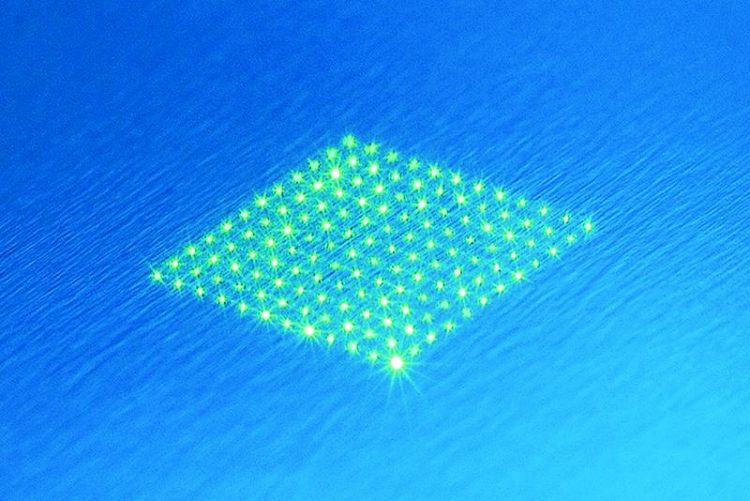Making ultrafast lasers faster

Array of multi-beams for parallelized ultrafast laser processing. © Fraunhofer ILT, Aachen, Germany
Ultrashort pulsed (USP) or ultrafast lasers can do something very unique: They ablate almost any material without causing a thermal load of the adjacent material.
Their cuts are smooth and melt-free, even on a micron scale. All of this makes ultrafast lasers very interesting for industries such as tool making, where hard materials must be processed very precisely.
In recent years, much progress has been made in developing ultrafast laser sources: Lasers with higher average power, higher pulse energy or higher repetition rate have become available.
They have been complemented by beam delivery systems, either based on ultrafast scanners or some special diffractive optical elements (DOE), that spread one beam into a pattern of many identical beamlets.
Although laser sources and beam delivery systems have improved remarkably, there is still room to grow, in particular when it comes to high-power lasers and high-efficiency processing technology.
The optical dot-matrix printer
A consortium of six partners from industry and research is now planning the next step in the development of the USP-laser process technology.
They will develop a powerful 1 kW laser source and combine it with a special optical system that delivers a pattern of more than 60 switchable beamlets. One can see this as a late descendant of the dot-matrix printer.
The consortium consists of the research institute Fraunhofer ILT and the RWTH Aachen University from Germany as well as Amplitude Systèmes, LASEA France, AA Opto-Electronic from France and LASEA from Belgium as industrial research and development partners.
The European Commission is supporting the project, named “MultiFlex”, within the framework of the program ICT-04-2018 for three years with an amount of € 4.7 million.
Delivery: High-end system ready for industrial use
The partners are looking beyond the already challenging system components: They intend to deliver a prototype with all the necessary control technology ready for the shop floor. It will start with a 1 kW laser machine that can deliver up to 1 mJ pulse energy either at the regular 1 MHz repetition rate or in a burst mode with less than 20 ns pulse separation.
The optical system converts the single laser beam into a pattern of more than 60 beamlets, where each single beamlet can be turned on and off separately. The resulting pattern can be directed onto the workpiece with a fast scanner. The complex system will be complemented by an industry grade control unit.
The resulting prototype will undergo an extensive series of tests and be validated in use cases provided by associated industrial end users. It has already been estimated that the prototype will improve the productivity by about 100 fold compared to current standard ultrafast laser processing systems.
This will not only allow for significant progress in the tool making industry, but also opens up new perspectives for the application of ultrafast lasers for the texturing and functionalization of large surfaces.
Funding
This project receives funding from the European Union’s Horizon 2020 research and innovation programme under grant agreement No 825201.
Dr. Johannes Finger
Group Micro- and Nano Structuring
Telephone +49 241 8906-472
johannes.finger@ilt.fraunhofer.de
Media Contact
All latest news from the category: Physics and Astronomy
This area deals with the fundamental laws and building blocks of nature and how they interact, the properties and the behavior of matter, and research into space and time and their structures.
innovations-report provides in-depth reports and articles on subjects such as astrophysics, laser technologies, nuclear, quantum, particle and solid-state physics, nanotechnologies, planetary research and findings (Mars, Venus) and developments related to the Hubble Telescope.
Newest articles

NASA: Mystery of life’s handedness deepens
The mystery of why life uses molecules with specific orientations has deepened with a NASA-funded discovery that RNA — a key molecule thought to have potentially held the instructions for…

What are the effects of historic lithium mining on water quality?
Study reveals low levels of common contaminants but high levels of other elements in waters associated with an abandoned lithium mine. Lithium ore and mining waste from a historic lithium…

Quantum-inspired design boosts efficiency of heat-to-electricity conversion
Rice engineers take unconventional route to improving thermophotovoltaic systems. Researchers at Rice University have found a new way to improve a key element of thermophotovoltaic (TPV) systems, which convert heat…



